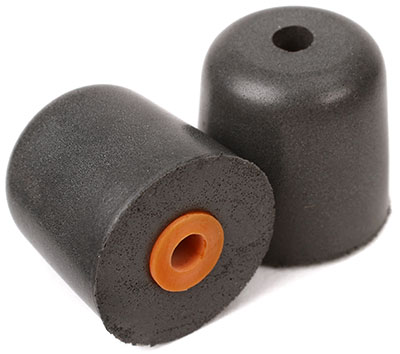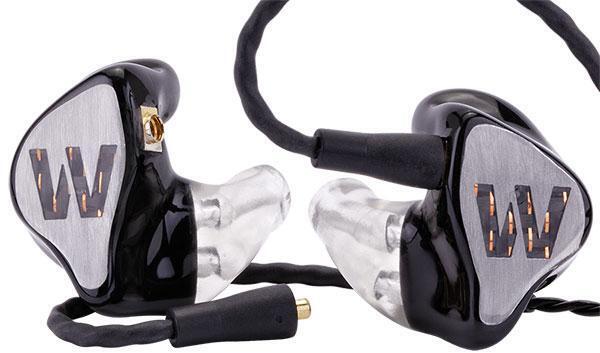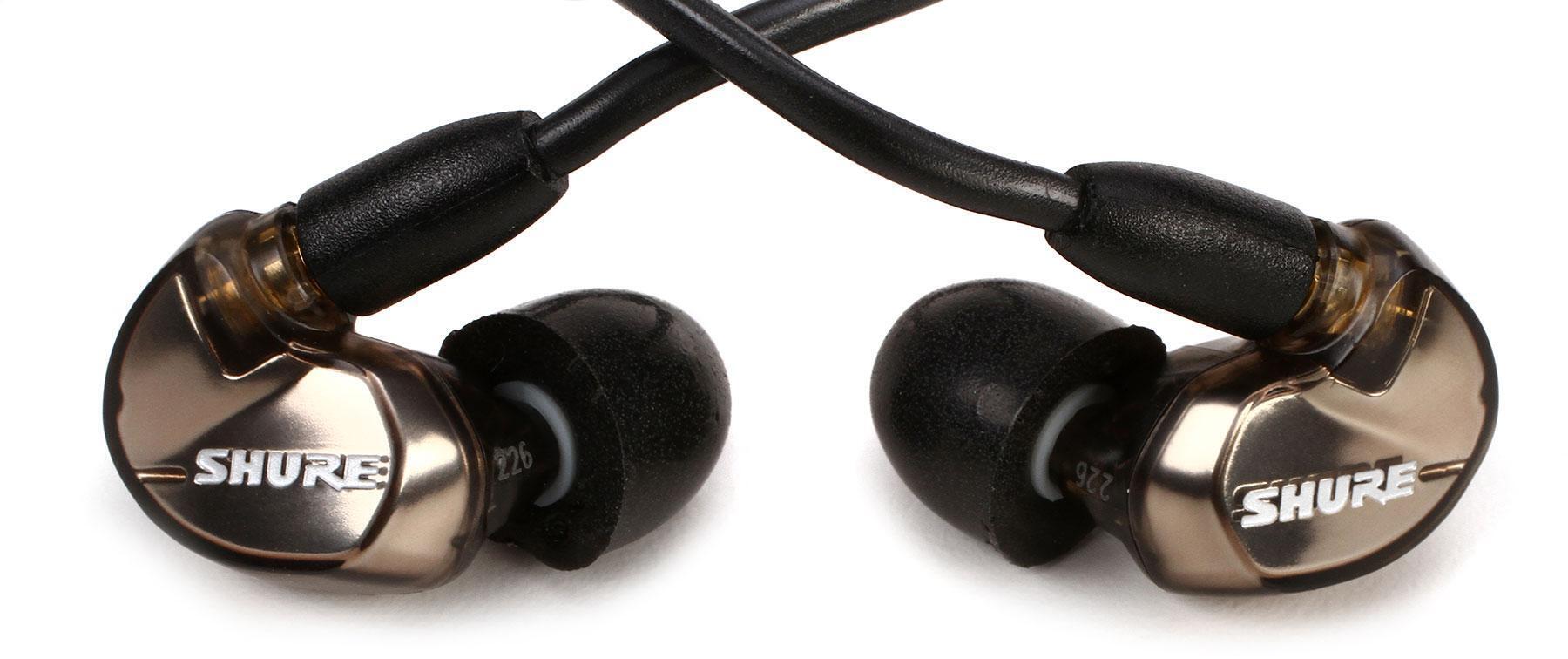From the live stage to the recording studio, the ever-growing trend toward personal monitoring continues to sweep the music-production world. So what’s the big deal? And once you’re ready to take the plunge, where do you start and how can you make an informed buying decision? Lucky for you, Sweetwater’s In-ear Buying Guide covers these questions and more to help you get exactly the in-ear system you need.
What Are In-ear Monitors?
In-ear monitors (in-ears or IEMs, for short) are professional-grade versions of what are commonly called earbuds or earphones in the consumer market. IEMs offer several distinct advantages for live performers, which is where they’re most popular. First, they allow you to reduce or possibly eliminate stage volume, which makes it easier to achieve a clear mix at a volume better suited for small to midsized venues. They’re particularly popular with worship musicians, because churches frequently present numerous acoustic challenges.
Next, in-ears deliver monitor mixes directly to a performer’s ears. That means you can move freely and never lose the ability to hear yourself, unlike performing with standard stage wedges. In fact, you’ll hear details you’d never make out in a high-stage-volume setting with traditional monitor speakers. That’s largely due to the next major advantage of IEMs.
The same mechanism that locks sound into your ears — acoustic isolation — also blocks outside noise, providing hearing protection that rivals or exceeds most dedicated earplugs on the market. That’s particularly important if you’re playing onstage with a mix of stage wedges and in-ears, or if you’re close to acoustic drums. Finally, IEMs tend to be small enough to virtually disappear from sight only a few feet away, so you can get the monitoring you need, without ruining the visual aesthetics of your stage.
Straight or Over-ear?
There are two basic configurations for in-ear monitors: the ones you stick in with cables that hang straight down, or the ones that wrap over the back of the ear. At the entry-level end of the spectrum, it’s all a matter of taste. Some people are initially uncomfortable with over-ear models, and there are a few high-quality straight in-ears to choose from.
The over-ear configuration is more or less universally preferred by serious performers. That’s because an over-ear configuration both secures your IEMs to your ears and hides the cables so they’re harder to spot. Once you get to professional-grade and custom-molded IEMs, straight isn’t even an option anymore.
Which Eartips Are Best?
The vast majority of in-ear monitors offer you the choice of foam or silicone eartips. But which are better, and for what? The truth of it is that it’s all a matter of taste, because foam and silicone eartips behave somewhat differently. For the most part, both do a great job staying in place, blocking out noise, and locking in the sound of your mix.
Silicone eartips use suction to stay in place, which makes them great for active performers. They tend to be slightly less isolating than foam eartips, but many find the trade-off for the added stability worth it and prefer their lighter feel. Foam, on the other hand, tends to be denser and more isolating, but the pressure they place on the ear canal can be uncomfortable, and they don’t handle sweat well.
Lucky for you, you don’t really need to choose. Many IEMs come with a sampler pack of eartips. For example, even the most basic Westones come with a full fit kit, including various sizes of both types of eartips. You can also buy a sample pack independent of the in-ears you have, and while there are different inner-diameters for various models, your Sweetwater Sales Engineer can help you find the right match for your favorite ‘phones.
What’s the Deal with Removable Cables?
You may have noticed that at a certain price, in-ear monitors all appear to come with removable cables. There are a few cool things about this. First, if you’ve ever known the pain of having to toss out a nice/expensive set of in-ears because the cable went bad, then you can appreciate being able to remedy that situation by simply swapping out a cable.
That’s the obvious benefit. However, it’s worth noting that most modern removable cables use MMCX connectors, making them interchangeable. Need a longer cable? A shorter one? Want to add an in-line remote for your iPhone or cut the cord entirely with a Bluetooth transceiver? All of these options are at your disposal when you go with a set of IEMs with a removable cable.
How Many Drivers Are Enough?
If you’ve taken a good look at the various in-ear monitors available at Sweetwater, you may have noticed that as the price goes up, so does the number of drivers packed into each earpiece. High-end IEMs can pack as many as eight micro drivers into a single earpiece! More is better, right? But unless you are buying a pair of top-of-the-line custom Westones, you may be wondering how many you need to get the results you want.
For starters, let’s look at why you’d want more than one driver to begin with. In this respect, the drivers in your IEMs are analogous to the number of speakers in a pair of studio monitors. With standard single-driver in-ears, the burden of re-creating the entire frequency spectrum rests squarely on one driver. While there are some truly impressive single-driver models out there, the fact is that there’s only so much a single driver can do, resulting in a limited frequency range, usually noticeable in the sufficiency of the low end.
When you step up to dual drivers per ear, your in-ear monitors start to resemble typical studio monitors. As in monitor speakers, these two drivers are separated by a passive crossover, allowing the full efficiency of one driver to go into reproducing low frequencies, while reserving the other for high frequencies. Add a third driver and a 3-way crossover into the mix, and you have a 3-way in-ear monitoring system with dedicated speakers for high, middle, and low frequencies, a combination that delivers deeper bass and greater clarity across the frequency spectrum.
So why go beyond three drivers? Without getting too technical about it, the answer still has to do with the overall efficiency of each individual driver. Even if they cover the exact same frequency range, every additional driver distributes the workload more broadly, allowing each to function more optimally. When IEMs double or triple up on drivers, you get to experience deeper lows (a top priority for bass players and drummers), clearer highs, and more articulate mids than you’ll get from only one driver per crossover band.
Universal Fit or Custom-molded?
If you’ve taken a look at the in-ears we carry, then you see that Sweetwater takes personal monitoring very seriously. We carry everything from humble earbuds to fully customized models fitted to the exact contours of your ear canals. But which delivers the best bang for your buck, universal-fit or custom-molded models? Not surprisingly, the answer is: it depends on what you need.
Let’s start by examining what goes into getting a pair of custom-molded IEMs. The process involves making an appointment with an audiologist to have impressions made of your ear canals (a process where an impression material is inserted into the ear canal to create a hardened mold that is removed and used to shape the custom earplugs). While the price for this will vary greatly depending on your insurance, Sweetwater has teamed with Westone to make the process itself easy. Our online customizer walks you through choosing your custom configuration and then provides you with ready-to-go paperwork you can take straight to your audiologist. It really couldn’t be easier.
This only leaves the question of which is the better value for the money, more drivers or custom-molded housings. We’ve already covered the benefits of increasing the number of drivers, so what do you get from custom-molded housings? For starters, if you’re going to regularly spend many hours wearing IEMs, then the sheer comfort of custom-molded housings is likely worth the investment alone.
But comfort is just one benefit of going with custom IEMs. The micro drivers used in in-ears, such as Westone’s balanced-armature drivers, are astonishingly detailed to begin with, but when they’re spaced perfectly for your ears, the detail and dimension you experience is second to none. Effectively, this makes custom-molded in-ears perform as well as or significantly better than universal models with one or more additional drivers.
Finally, there’s the matter of acoustic isolation. Both universal and custom in-ear monitors gain the majority of their isolation from the fit of the eartips themselves, but as any acoustics expert will agree, isolation is only as strong as the weakest link. Custom-molded earpieces actually fit snugly inside the outer ear, allowing the housing itself to bolster their isolation in ways universal-fit IEMs can’t provide. The result is greater isolation, which protects your ears in two ways: it decreases the effects of stage volume, and it lets you back down on the volume in your monitor feed. Arguably, this is an even greater benefit in the studio, where extreme volumes are often essential for recording high-quality audio.
Live Mixing Tips for In-ear Monitoring
One of the tricky things about switching to a silent stage, or even incorporating in-ear monitors into your live rig, is the way you need to adjust your approach to monitor mixing in general. Typical live mixing involves miking up only those instruments that will otherwise get lost in the rest of the sound-reinforcement system. Most of the time, this isn’t really an issue onstage, since the performers will hear the louder sources the same way the audience will, meaning you only need to use the elements already in the main sound-reinforcement mix in the monitor mix. All of that changes when you switch to IEMs.
Mic Everything
Since IEMs regularly offer upward of 24dB of acoustic isolation, even the louder elements onstage won’t come through clearly in the monitor mix. That means you’re going to have to create a mix that more closely resembles a studio approach to miking, including placing microphones on every sound source. That doesn’t mean you have to mic every drum, but you will need to mic the kit, even if it’s just a couple of mics to cover the whole kit. This sometimes requires additional microphones and mixer channels, though you don’t need ultra-high-quality mics.
Add Ambience
Another complaint musicians making the transition to IEMs often express is the loss of connection they feel with their audience as a result of the extreme acoustic isolation in-ears provide. The simplest solution to this is to place a couple of microphones pointing out at the audience. Due to the potential phase issues this can cause as sound bounces off the back of the venue, you’ll want to keep the volume of these mics fairly low in the mix, but a little goes a long way. By the way, if you have the choice to go with mono or stereo mixes, go with stereo — it’s far less disorienting.
Pro Tip
Since using in-ear monitors effectively requires you to mic the stage as though you were recording the band, you might as well throw a recording device into your rig. You can take an aux feed for a quick mix that’s ready to upload on YouTube or wherever right away. If your board has direct outs, then you can even multitrack your mix for even more professional results.
Manage Mixes
With detailed monitoring piped directly into your artists’ ears, getting the mix right for your performers is a bit trickier and more critical than ever. Of course, you can get away with a compromise mix that satisfies everyone equally, but the better option is providing your artists with the ability to create individual custom mixes. If you have enough aux outs, this isn’t much of a problem. Likewise, direct outs feeding systems like those made by Aviom or Hear Technologies are great for this sort of application, and several modern digital mixers even allow artists onstage to control their own mixes via Bluetooth mobile devices!
Going Wireless
Finally, there’s the matter of whether to go wireless. Wireless monitor systems were developed specifically for IEM systems, and they provide musicians with a level of convenience that’s impossible to ignore. Even if you aren’t using wireless microphone and instrument systems, the fact that you don’t have to worry about another cord lying on the stage is very appealing, and any performer can appreciate that. What’s more, many high-end wireless monitoring systems incorporate some degree of personal mixing, cutting out the need for other monitoring gear.
What’s the Next Step?
There are a lot of factors to consider if you want to switch to in-ear monitors. Nonetheless, the performers here at Sweetwater agree that it’s totally worth it, not only for your audience, but also for your own performance and hearing protection. While we’ve tried to cover all the major aspects of in-ear monitoring in this buying guide, you may still have questions. Please don’t hesitate to give us a call at (800) 222-4700 — your Sweetwater Sales Engineer will be happy to help you find the best system to meet your needs.
In-ear Molds for Free?
If you decide you want custom-molded in-ears and you’re near Fort Wayne (or need a good excuse to visit), we can make your ear molds for free (a $100 value) when you purchase a pair of Westone in-ear monitors. Our staff medical professionals are Westone-certified to create custom in-ear molds in our on-site medical clinic. Just call your Sales Engineer for details and to schedule your visit.








